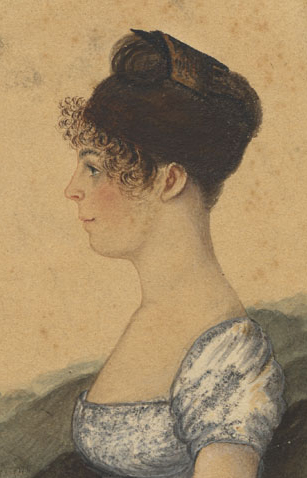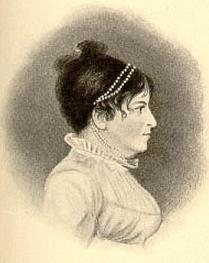|
Craig White's
authors |
 Susanna Rowson |
Susanna Rowson (1762-1824) |
 |
Susanna Rowson is best known today as author of Charlotte Temple (1791, 1794), the early United States' most popular novel before the 1850s, when Elizabeth Warner's The Wide, Wide World (1850), Harriet Beecher Stowe's Uncle Tom's Cabin (1852), and other best-selling women's novels appeared.
In her lifetime—a long life for that era, helped perhaps by not having children—Mrs. Rowson (as she would then have been called) was well known as the author of several other novels but also as an actress, the manager of a troupe of actors, a writer of popular melodramas and songs, and a founder of early schools for girls, for whom she wrote specialized textbooks, .
Mrs. Rowson's career is of interest to cultural historians for her Trans-Atlantic identity, some variation of which many Americans shared. Susanna Haswell was born in England in 1762; her mother died ten days later. In 1763 her father, a lieutenant in the Royal Navy, was transferred to the British colony of Massachusetts to work in customs (i.e. taxes on imports). There he married again, and Charlotte was brought from England to America in 1767. For most of the next decade she lived in the Nantasket Beach area near Hull, Massachusetts, not far from the original Pilgrims' colony at Plymouth. Susanna enjoyed the outdoors, read in her father's library, and was friendly with James Otis (1725-83), a friend of Thomas Paine and an early political agitator for rights for Americans including African Americans.
During the American Revolution, continental patriots took Lieutenant Haswell prisoner with his family. For three years the family was moved from one detention site to another. Amid these deprivations, the teenaged Susanna organized the household and sought assistance from old friends. In May 1778 prisoner exchange eventually returned Lieutenant Haswell and his family (including a new wife) to England. The family having lost most of its property, Susanna helped by working as a governess, a typical employment for a young woman of middle-class status.
In the early 1780s Susanna began working on the stage and published her first book, A Trip to Parnassus (1784), drama criticism that demonstrated wide knowledge of the London theatrical world. In 1786 she married William Rowson, a hardware merchant who provided materials for and built theater sets, occasionally acted, and played the trumpet professionally. He brought to the marriage an inclination to alcoholism and an illegitimate son for whom Susanna served as stepmother. As a woman operating under the legal strictures of the times, her husband William had to sign all her contracts with publishers and producers, but she appears to have been the productive partner in their marriage, which endured till her death.
In 1786 Susanna Rowson published her first novel, Victoria.
|
In 1790 in England, Rowson first published the novel now known as Charlotte Temple under the title Charlotte, a Tale of Truth. The novel was mildly successful in England. In 1792 another of Rowson's novels, Rebecca: or the Fille de Chambre, sold well in the United States, and in 1794 Charlotte Temple was republished in the USA to great success, with 47 editions appearing before 1820. The story was also dramatized as a popular melodrama, much as Uncle Tom's Cabin would be two generations later. Given the laxity of international copyright laws especially in the United States, a number of these editions were probably pirated. (The US as a new entity among modern nations had a casual attitude toward intellectual property rights and copyright piracy, much like China around the new millennium.) Most editions were published in Philadelphia and New York, with only one edition in Boston's, showing the novel's popularity in the growing mid-Atlantic region. The character of Montraville may have been based partly on the amorous career of Rowson's first cousin, John Montresor (1736-99), a British military engineer stationed in North America during the American Revolution. |
|
Between the two publications of Charlotte Temple, Thomas Wignell (1753-1803), whose Old American Theatre had been closed along with other American theatrical companies during the Revolution, opened his New American Theatre in Philadelphia. In 1793 Wignell invited the Rowsons—who had only middling success in London—to return to America. The new company proved a success, with Mrs. Rowson playing mostly secondary roles but contributing plays and songs for the theater's productions. Only one of Rowson's plays, Slaves of Algiers (1794) survives. During this period she also wrote an opera.
|
In 1796 the Rowsons joined the Federal Street Theatre in Boston. Susanna Rowson's last appearance as an actress was in 1797. That same year in Boston she opened the Young Ladies Academy, a forerunner of the new educational opportunities that would rise with the founding of Mt. Holyoke, Bryn Mawr, Smith, Vassar, and other of the "Seven Sisters" colleges for women between 1837 and 1889. Among the textbooks Rowson wrote for her students and others was Youth's first Step in Geography (1811). During her remaining years her family came to include two adopted daughters and the widow and children of her brother, who was lost at sea in 1801. One of these nieces became the great-grandmother of the 20th-century poet E. E. Cummings. Susanna Rowson retired from teaching in 1822 and died two years later. Her last novel, Charlotte's Daughter; or, The Three Orphans. A Sequel to Charlotte Temple, also known as Lucy Temple, was published posthumously in 1828. |
|
Some Works by Susanna Rowson:
A Trip to Parnassus (1784)
Victoria (1786)
Mary, or, The Test of Honour (1789)
Charlotte, a Tale of Truth (1790, England; 1794, USA; retitled Charlotte Temple 1797)
Mentoria (1791)
Rebecca: or the Fille de Chambre (1792)
Slaves of Algiers; or, A Struggle for Freedom (1794)
Trials of the Human Heart (1795)
Reuben and Rachel (1798)
Sarah; or the Exemplary Wife (1813)
Charlotte's Daughter; or, The Three Orphans. A Sequel to Charlotte Temple, a. k. a. Lucy Temple (1828).
Sources:
Ann Douglas. Introduction. Charlotte Temple and Lucy Temple. NY: Penguin, 1991. vii-xliv.
"Susanna Rowson." Wikipedia. Retrieved 11 April 2014.
http://public.wsu.edu/~campbelld/amlit/rowson2.html: Harper’s, June 1853: "Hundreds of readers who would sleep over a sermon, or drone over an essay, or yield a cold and barren assent to the deductions of an ethical treatise, will be startled into reflection, or won to emulation, or roused into effort, by the delineations they meet with in a tale which they opened only for the amusement of an hour."
Four American Critics on Charlotte Temple

Charlotte's Daughter; or, The Three Orphans. A Sequel to Charlotte Temple, a. k. a. Lucy Temple (1828).
Notes from Penguin edition of Lucy Temple
II, 138 Lucy > Blakeney
IV, 156-7 self-reliance + providence
158 clubs, plays
162 Methodists
168 summer 1794, Lucy 20
V, 179 [Montraville]
180 men + profligate women
181 master of person, possession of property
IX, 216 name of N--
218 miniature CT
x, 223 one fault, x-banish
224 bad woman = bane of man's peace
225 x-forward letters
XI 231 picture of mother, own daughter
XIV,. 240 little seminary

